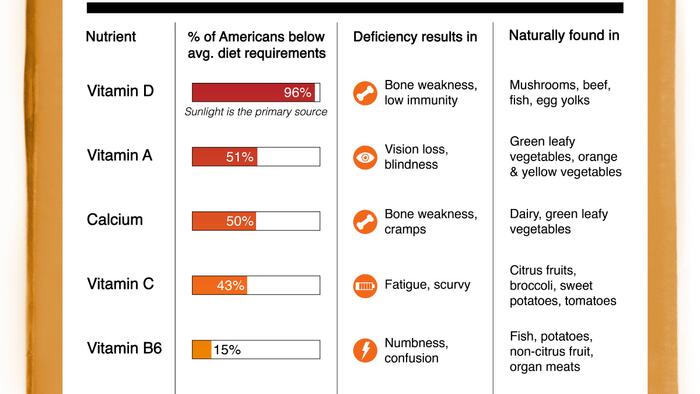The infographic presented by Visual Capitalist, featuring insights from the Micronutrient Information Center at Oregon State University, provides a detailed overview of prevalent nutrient deficiencies among the American population, specifically among adults aged 18 and older. It highlights the estimated average requirement (EAR), which is the minimum dietary intake needed to satisfy the nutritional needs of half the individuals in a particular age and gender demographic. The data underscores the reality that many Americans struggle to meet these basic nutritional requirements due to various lifestyle and dietary choices, often resulting in significant health concerns.
Among the most significant nutrient deficiencies identified are calcium and Vitamin D. Many Americans fail to acquire sufficient amounts of Vitamin D, which is notoriously difficult to obtain solely through diet. While the body can produce Vitamin D when exposed to sunlight, the recommended exposure time is at least 15 minutes daily; however, individuals with darker skin tones might require longer durations to synthesize adequate amounts. The consequences of Vitamin D deficiency can manifest in muscle and bone aches, fatigue, depressive symptoms, and, over time, serious conditions such as osteoporosis. Dietary sources of Vitamin D include mushrooms, beef, fish, and egg yolks, along with fortified products like milk and breakfast cereals, which aim to enhance dietary intake.
In addition to Vitamin D, Vitamin A is another nutrient that many Americans lack, with estimates suggesting that around 50% of the population does not meet the dietary requirements for this essential vitamin. The implications of Vitamin A deficiency can be severe, potentially leading to issues like vision loss, skin problems, delayed wound healing, and infertility. These deficiencies highlight a concerning trend attributed to the consumption of energy-dense but nutrient-poor diets prevalent in America. Many diets are overly reliant on processed foods and simple carbohydrates, which do not provide adequate levels of essential vitamins and minerals.
The infographic also points toward a broader pattern in American dietary habits and its implications on health. By favoring processed foods over nutrient-rich alternatives, many individuals inadvertently deprive themselves of essential nutrients needed for optimal physical and mental well-being. Health professionals and dieticians advocate for a shift towards more nutrient-dense choices, including a diverse array of fruits, vegetables, quality meats, dairy products, and whole grains, all of which can provide essential nutrients necessary to meet dietary requirements.
The relationship between dietary deficiencies and overall health cannot be overstated; the rise in obesity rates in America is emblematic of the underlying challenges posed by such nutrient imbalances. The infographic serves as a reminder that while many Americans are consuming sufficient energy, the nutritional value of that energy remains critically low. Recognizing the deficiencies and addressing them through informed dietary choices is crucial for enhancing public health and mitigating the risks of chronic diseases.
In summary, the visual data reinforces a pressing need for dietary reform at both individual and societal levels. By highlighting the critical nutrients that are commonly insufficient in the American diet—namely Vitamin D, calcium, and Vitamin A—the infographic encourages a broader discussion on nutrition, lifestyle changes, and the profound impact of dietary choices on health outcomes. It also invites Americans to consider the importance of shifting towards a more balanced and nutrient-dense diet to enhance their overall health and well-being, countering the trend of nutrient deficiencies that has become increasingly prevalent in modern society.

